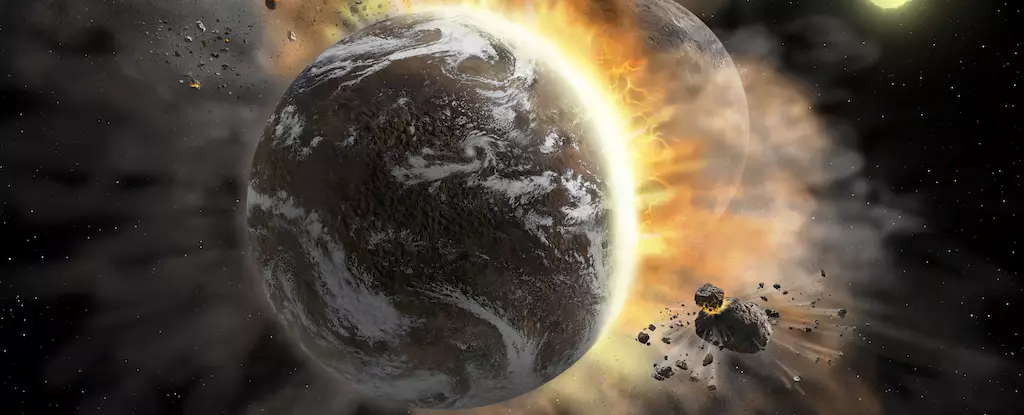The cosmos is a chaotic, vibrant arena where worlds collide, merge, and evolve. This spectacular turmoil is perhaps best illustrated by the Moon, whose cratered landscape speaks volumes about a tumultuous past riddled with celestial impacts. To comprehend the early Solar System’s volatility, we must consider that every young solar system—much like our own—experienced similar cataclysms. Recent research has taken a deep dive into this phenomenon, highlighting how colossal crashes between massive planets can mold the future of their celestial counterparts.
The Quantum of Cosmic Collisions
Astronomers have long posited that exoplanets could grow disproportionately large due to their history of collisions with smaller celestial bodies. A groundbreaking study simulated the cataclysmic interaction between two gas giants—one in its formative years and the other a more advanced, massive gas giant. The research, led by J.J. Zanazzi from UC Berkeley, aims to discern the seismic aftermath of such colossal impacts. The initial focus is whether these impacts generate seismic waves—tremors that could announce their presence far beyond their cosmic shores.
While the James Webb Space Telescope (JWST) isn’t outright capable of detecting seismic waves, it possesses remarkable photometric precision that could record changes in light caused by seismic disturbances. The authors of the study assert that these seismic oscillations might be identified through minor fluctuations in brightness, effectively allowing us to “see” the hidden seismic world of exoplanets. With our eyes set on Beta Pictoris b—a young exoplanet rich in heavy metals—the research proposes that detecting seismic waves could serve as an innovative tool for understanding exoplanetary inner workings.
The Exoplanetary Goldmine of Beta Pictoris b
Beta Pictoris b stands as a tantalizing specimen in the quest to decipher planetary formation and evolution. This gas giant, boasting around 13 times the mass of Jupiter and a youthful age of approximately 12 to 20 million years, shows signs of significant metal enrichment, potentially from vigorous planetesimal accretion. The idea that this young super-Jupiter could harbor between 100 and 300 Earth masses’ worth of metals transforms it into a focus point for future astronomical studies.
In simulations simulating a collision with a Neptune-mass planet (approximately 17 Earth masses), the research reveals a wealth of information about how seismic activity can be triggered and sustained over a young planet’s lifecycle. Specifically, these impacts could lead to discernible variations in Beta Pictoris b’s luminosity, observable by the JWST if such collisions occurred within a prior 9 to 18 million years—a cosmic blink.
A New Era of Planetary Seismology
The pioneers of this research suggest that employing seismological techniques could yield valuable insights into the detailed internal structures of giant planets, a method that hasn’t been fully explored in the realm of exoplanets. Traditional approaches have depended on gravity measurements, which are limited to planets within our Solar System. However, the novelty of applying seismic wave detection to distant celestial bodies could open unexplored pathways, offering a deeper understanding of their interior dynamics.
By recognizing the frequencies of long-lived seismic waves produced by impactful collisions, scientists can infer critical data regarding a planet’s bulk density and internal stratification. Furthermore, the implications extend beyond seismic observation; the study notes that high-eccentricity migration—driven by tidal interactions with host stars—could also generate oscillations that are detectable through subtle changes in light curves.
The Cosmic Symphony: Implications for Exoplanet Studies
The ramifications of this research extend far beyond understanding the seismic oscillations of massive exoplanets. The ability to detect seismic waves, coupled with photometric changes, may eventually lead to groundbreaking revelations about planetary migrations, formation histories, and the very nature of planetary solid materials.
The study pointers toward an exciting time in the field of astronomy, ushering in an era where we can glean new insights about the elusive interiors of gas giants and their evolutionary tales. As technology continues to advance, we are at the cusp of a new frontier in understanding the universe—one that interweaves the violent history of the cosmos with the cool equilibrium of planets today.
In a universe shaped by chaos and collisions, understanding the seismic signals of faraway worlds may become a powerful tool for unraveling the mysteries of planet formation and evolution. The implications of these findings not only promise to enhance our knowledge of exoplanets but could potentially redefine our understanding of life’s origins within swirling stardust and colliding worlds.


Leave a Reply